A blog about how-to, internet, social-networks, windows, linux, blogging, tips and tricks.
05 July 2018
9 Cheap Web Hosting Sites That Cost Under $3.50 Per Month

These days, web hosting can be dirt cheap. Mainstream services start somewhere around $5 per month, which is quite cheap already, but if you dig a little deeper, you can find affordable web hosts for as little as $1 per month.
Here are some of the cheapest web hosting sites available today, all priced at under $3.50 per month. For less than the price of a Starbucks latte every month, you can run your very own website for the world to see. Exciting, isn’t it?
With the exception of one, all of these are shared web hosts.
Disclaimer: As with most things in life, you get what you pay for. If you plan on running a website with heavy traffic, use one of these top web hosting services instead.
1. Bluehost (Special Rate: $2.95/mo)
First launched in 2003, Bluehost has grown into one of the world’s most well-known and recognizable web hosts.
The service sells itself on a painless setup process and general ease of use, which is why Bluehost is an oft-recommended hosting option for WordPress bloggers with no technical experience. Their customer service could be better, but server uptime is reliable.
Bluehost’s Basic plan normally costs $7.99/mo, but if you sign up using this link, you can get the same plan at a special discounted rate of $2.95/mo.
Server locations:
- Utah, US
- China
- Hong Kong
- India
- United Kingdom
Hosting plan details:
- 50GB storage (HDD)
- Unlimited monthly traffic
- 1 free domain for the first year
- 5 email addresses
- Enhanced cPanel is available
- Free SSL certificate through Let’s Encrypt
- Supports PHP, CGI, Perl, Python, Ruby on Rails, MySQL, and PostgreSQL
2. 97cents.net ($0.97/mo)
The team behind 97cents has been hosting websites since 1996, so you can rest assured that they know what they’re doing. How is it so cheap? Because they don’t offer unlimited anything. By enforcing reasonable limits, they’re able to provide reliable service while passing the savings onto you.
Server locations:
- Nevada, US
- Australia
- Germany
- Japan
- Luxembourg
- Singapore
- United Kingdom
Hosting plan details:
- 197 MB storage (SSD)
- 9,700 MB monthly traffic
- 1 hosted domain
- 10 email addresses
- cPanel is available
- Supports PHP, CGI, Perl, and MySQL
- Daily backups for your convenience
3. Viva La Revolution ($1.00/mo)
If you can look past the name, Viva La Revolution is a pretty strong choice for a cheap-as-pennies web host. That being said, if the $1.00 plan is too weak for you, they also offer $2.00 and $5.00 plans that are both excellent for their prices.
Server locations:
- United States
- Germany
- Italy
Hosting plan details:
- 1 GB storage (SSD)
- 15 GB monthly traffic
- 1 free subdomain provided
- Webmail is available
- Easy-to-use control panel
- Supports PHP, CGI, Perl, and MySQL
4. Warpline Hosting ($1.00/mo)
Warpline Hosting offers a lot of resources for the price, which is why they’re popular. But as with most shared hosting solutions, traffic spikes can overload servers and cause performance hits. They also offer $2.00 and $3.00 plans that are great, too.
Server locations:
- Missouri, US
Hosting plan details:
- 10 GB storage
- 100 GB monthly traffic
- 1 hosted domain
- Webmail is available
- cPanel is available
- Supports PHP, CGI, Perl, Python, Ruby, and MySQL
5. No Support Linux Hosting ($1.00/mo)
As their name implies, No Support Linux Hosting offers affordable web hosting on Linux servers but absolutely no support whatsoever. Without any customer service overhead, they can pass the savings onto you. As such, we only recommend this host if you have previous experience with running a website.
Server locations:
- Iowa, US
Hosting plan details:
- 1 GB storage (SSD)
- 30 GB monthly traffic
- 1 hosted domain
- 25 email addresses
- cPanel is available
- Supports PHP, CGI, Perl, and MySQL
6. RamNode ($1.25/mo)
RamNode is an exception on this list. Instead of shared web hosting, they provide virtual private servers—which can be used for web hosting but aren’t limited to just that. In fact, there are many reasons to prefer a VPS over shared hosting.
And seeing as how RamNode is significantly cheaper than most web hosts, it seems only relevant to include it on this list.
Server locations:
- New York, US
- Georgia, US
- Washington, US
- California, US
Hosting plan details:
- 12 GB storage (SSD)
- 500 GB monthly traffic
- 128 MB RAM / 64 MB VSwap
- Uses OpenVZ for virtualization
- Requires more knowledge than simple web hosting
7. Watt Hosting ($2.50/mo)
Watt Hosting is actually the sister site to the aforementioned 97cents. Since 97cents only offers one cheap hosting plan, you’ll have to move on once you outgrow it. So, if 97cents isn’t enough for you, then Watt Hosting’s bigger plans might be exactly what you need.
Server locations:
- Nevada, US
- Australia
- Germany
- Japan
- Luxembourg
- Singapore
- United Kingdom
Hosting plan details:
- 1 GB storage (SSD)
- 20 GB monthly traffic
- 1 hosted domain
- 20 email addresses
- 2 FTP accounts
- 3 databases
- cPanel is available
- Supports PHP, CGI, Perl, and MySQL
- Daily backups for your convenience
8. Namecheap ($2.88/mo)
Namecheap started as a domain registrar but soon expanded into a full-fledged web host. They used to offer an insane introductory rate of $0.82/mo for the first year, but their current rate of $2.88/mo is still very good. And unlike most of the web hosts on this list, Namecheap’s customer support is beyond excellent.
Server locations:
- New Jersey, US
- Georgia, US
- Texas, US
- Arizona, US
Hosting plan details:
- 20 GB storage (SSD)
- Unlimited monthly traffic
- 3 hosted domains
- 50 email addresses
- cPanel is available
- Supports PHP, CGI, Perl, and MySQL
- Daily backups for your convenience
9. AHosting ($3.33/mo)
AHosting is probably the least impressive package on this list, but if the other services just aren’t working out for you, then you may want to consider this one as it’s still cheaper than a lot of other web hosts out there.
Server locations:
- Michigan, US
- Florida, US
Hosting plan details:
- 5 GB storage
- 50 GB monthly traffic
- 1 hosted domain
- Unlimited subdomains
- Unlimited email addresses
- cPanel is available
- Supports PHP, CGI, Perl, Ruby, and MySQL
- Daily backups for your convenience
Which Cheap Web Hosting Is Right for You?
Personally, I’ve been using Namecheap for years and never had any issues with them. They aren’t the cheapest on this list, but they’re worth it for superior customer service.
Bluehost is another high-value option with the discounted rate you can get using this link.
Regardless, we recommend going with an SSD-based web host whenever possible. Want to go even cheaper than the web hosts on this list? Consider one of these free and easy-to-use web hosts, but be aware of the downsides to using a free web host.
Read the full article: 9 Cheap Web Hosting Sites That Cost Under $3.50 Per Month
Read Full Article
ZTE replaces its CEO and other top execs
A number of top executives are out at ZTE as the phone maker works to fulfill the requirements of U.S.-imposed restrictions. Among the big changes up top is new CEO Xu Ziyang, who formerly headed up the company’s operations in Germany. A new CFO, CTO and head of HR have been named, as well, according to The Wall Street Journal.
The move comes a few days after company slowly began to resume some business operations on a one-month waver, following a seemingly D.O.A. seven-year export ban. The ban was announced back in April, after the company failed to appropriately punish top employees over Iran/North Korean trade violations.
Trump, however, was quick to toss the company a lifeline, citing potential job loss in China. The President’s willingness to bail out ZTE has been met with staunch criticism by many, including members of his own party. A bipartisan push in Congress to reinstitute the ban began in Congress last month. Many of the issues appear to stem from ties to the Chinese government that also put Huawei in hot water with U.S. security orgs.
For now, however, the company appears to be springing back to life, as it rushes to comply with the most recent laundry list of restrictions. The moves come in the wake of a $1 billion fine and the effective freeze on operations as the company mulled a way forward without relying on products from U.S. businesses like Google and Qualcomm.
In that time, ZTE has lost billions, and grappled with other…inconveniences. Of course, even with these changes, the company isn’t out of the woods just yet. In addition to on-going financial issues, security and other concerns could be enough to put consumers in the U.S. and other countries off the company altogether.
Read Full Article
Tesla adds autonomous parking mode to Model 3
The Model 3 can now park itself. Called Summon, the feature is now available on the company’s new sedan.
It’s a clever feature that takes advantage of the vehicle’s connectivity and autonomous driving capabilities. With Summon owners can command their Model 3 to pull into a parking spot and power down. It can even control garage doors — all without a driver behind the wheel or controlling the vehicle remotely. Tesla added the feature to Model S and Model X vehicles last year.
Note, no one is in the car or controlling remotely. Car is driving entirely by itself. https://t.co/xSG2Mmy756
— Elon Musk (@elonmusk) July 5, 2018
This is the latest feature Tesla added to the Model 3 after its launch. The company is in a frenzy to keep up with production goals and the nature of the Model 3’s connected platform allows the company to added features to already-built vehicles.
Read Full Article
How to Capture and Instantly Share Screenshots for Free Using CloudApp

Chances are you already know how to take a screenshot on your Mac. It’s relatively easy to do, and comes with advantages and disadvantages.
But sharing those screenshots? Not so easy.
Packing up screenshots into a shareable link is an important feature for a lot of users. And CloudApp is one of the best solutions for this. It’s easy to use, reliable, and comes with a generous free plan.
Let’s see how you can use CloudApp to take and exchange screenshots, screen recordings, files, GIFs, annotations, and media through instantly shareable links.
How to Take Screenshots With CloudApp
Head to CloudApp’s signup page to get started. Sign up with your Google account or create a CloudUp account, then you’ll be prompted to download the app for your platform. CloudApp is available for Windows, Mac, and Chrome. We’ll use the Mac version in this overview.
The Mac menu bar component hosts CloudApp, making it accessible all the time. You can take screenshots by selecting the app’s and choosing the Photo button.
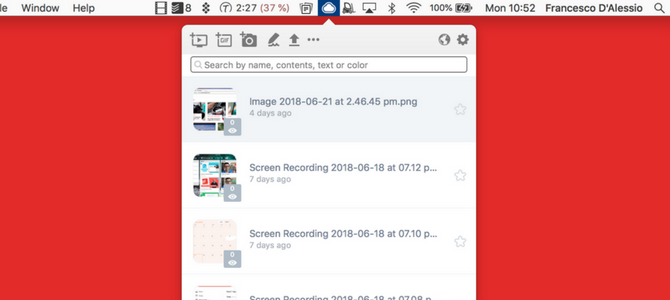
Using a keyboard shortcut, you can access this instantly using Shift + Cmd + 5. Once you’ve opened up the selection tool, snap a screenshot as you would with any other tool.
Once you’ve grabbed a screenshot, CloudApp instantly captures it as a link. What’s more, it immediately places the link on your clipboard. Paste this into a browser, and you’ll see your screenshot on its own page.
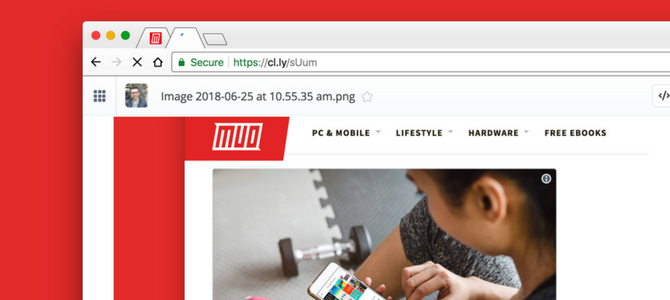
From this webpage, you can go further. Click the Embed button to grab HTML code for embedding on your website, or Annotate to mark it up.
Feel free to share screenshot links anywhere it’s convenient, such as Slack or social media.
How to Record Your Screen With CloudApp
Capturing your screen is a great way to visually demonstrate what’s in front of you. A quick screen recording can explain a problem you’re having, illustrate an idea, or capture something important.
You can do all this via CloudApp’s screen record tool.
Start by opening up CloudApp via the menu bar. Select the first icon, which looks like a screen with a play button inside. Then choose the area you wish to record.
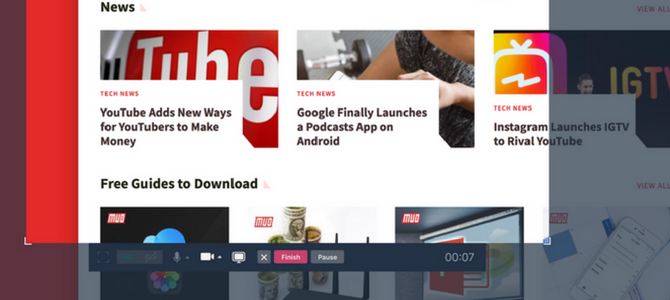
From this screen, you can use a few extra features to enhance your recordings, such as voice recording and webcam bubbles. This is perfect when who want to add context to a recording.
Once everything looks good, hit Record. You can record the screen with your webcam and voice narration running at the same time. After you’ve completed the recording, the shareable link will hop onto your clipboard, ready to share with the world.
Note that screen recording files take longer to upload than screenshots. You should thus wait a few moments before sharing a link with your client or colleagues, simply to avoid confusion.
How to Capture a GIF With CloudApp
Looking to demonstrate a GIF? You can also do this from the toolkit.
This feature comes in handy if you’re looking to explain something without a full-screen recording. GIF files are smaller in size and more portable than videos.
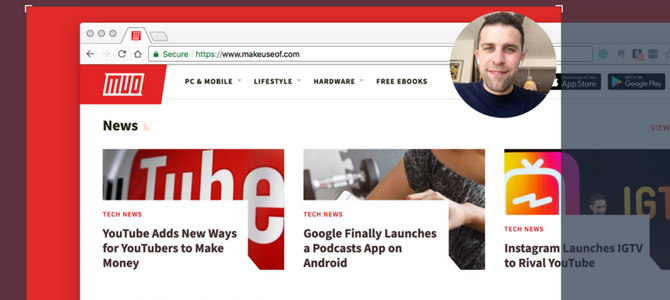
Creating a GIF is similar to screen recording, and it also allows you to add webcam or voice narration. Choose the GIF tool inside the CloudApp menu bar icon.
From here, you can position the screen and hit Record. The GIF recording will capture frame by frame, giving you a shareable link to share anywhere.
By no means is CloudApp a GIF specialist. But it does provide a simple GIF creation service that is perfect for fast capture.
How to Share Your Screenshots With CloudApp
Extended tools in CloudApp allow you to go further.
Open the menu bar icon and you’ll find a library of your past screenshots, recordings, and GIFs (with limited storage in the free plan). From this library, you can copy links, download the original files, and even annotate.
Annotation allows you to modify screenshots with a range of editing tools. This is perfect for adding additional explanation.
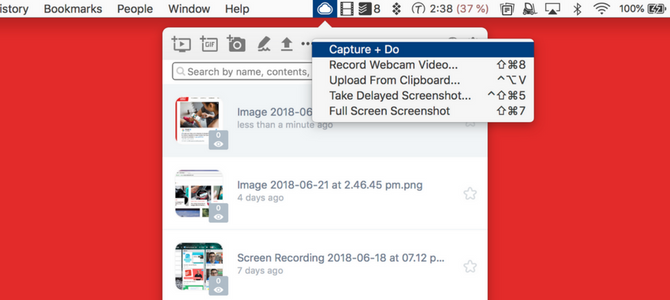
The toolkit also has the ability to take delayed screenshots and fullscreen shots, to avoid using the clipper tool. Sharing files and documents using a secure link is also possible here.
CloudApp also has the option to open downloads and native screenshots inside the CloudApp, ready to share. However, this limits your storage and use of the tool.
How Do Similar Screenshot Tools Compare?
CloudApp isn’t the only quick screen capture tool available. There are a host of alternatives that allow you to capture and share screen recordings with ease.
Loom is one of those close competitors. It’s lightweight thanks to its only offering being a Chrome extension—there’s no need to install a Mac or Windows program.
Taking a screen recording with Loom is easy, and offers a range of options. First, you can choose whether you’d like to record a Screen & Cam or just the Screen or Camera.
From here, you can record either the full desktop or just the current tab.
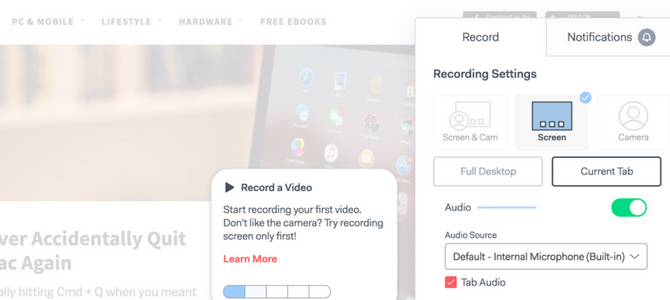
Loom, like CloudApp, lets you explain something via video instead of a long description. Plus, Loom is totally free, though it does plan to add premium features soon.
One big drawback of Loom is that it doesn’t take screenshots. Yet it offers unlimited storage for your screen recordings. This contrasts with CloudApp, which limits you to a time limit per screen recording and finite file storage.
Another competitor, Droplr, allows you to share screenshots and files instantly. This gives it an edge on Loom’s free app, but Droplr locks the screenshot and screen recording technology under a monthly pro subscription.
Is CloudApp the Right Tool for You?
CloudApp offers a free plan with a few limits. This limits you to 25 shares per month, with recordings and GIFs capping out at 15 seconds. The $8/month Pro plan unlocks unlimited shares and removes the time limit on screen recordings. It also lets you upload larger files and increases your maximum storage.
If you only share media occasionally and find quick sharing a pain point with your current implementation, CloudApp’s free plan is definitely worth a look. Serious sharers get a lot for just a few dollars per month too.
To share without a tool like this, check out the best ways to share files with anyone over the web.
Read the full article: How to Capture and Instantly Share Screenshots for Free Using CloudApp
Read Full Article
Here are the 16 best computer bags TechCrunch reviewed in Bag Week 2018
Welcome to Bag Week 2018. Every year your faithful friends at TechCrunch spend an entire week looking at bags. Why? Because bags — often ignored but full of our important electronics — are the outward representations of our techie styles, and we put far too little thought into where we keep our most prized possessions.
Over the last couple weeks TechCrunch reviewed computer bags. We featured waxed canvas bags, camera backpacks, trail-ready commuter bags and bags designed with women in mind. Here’s a round-up of most of the bags. Did we fail to feature your favorite bag? Drop a comment below or email TechCrunch at tips@techcrunch.com.
Read Full Article
Tinder Loops, the dating app’s new video feature, rolls out globally
Tinder Loops, the recently announced video feature from Tinder, is today rolling out globally.
Tinder has been testing this feature in Canada and Sweden since April, when it was first announced, and has rolled out to a few other markets since then.
Today, Loops are available to Tinder users across the following markets: Japan, United Kingdom, United States, France, Korea, Canada, Australia, Germany, Italy, Netherlands, Russia, Sweden, Belgium, Denmark, Iceland, Ireland, Kuwait, New Zealand, Norway, Qatar, Saudi Arabia, Singapore, Switzerland, Taiwan, Thailand and United Arab Emirates.
Loops are two-second, looping videos that can be posted to users’ profiles. Users can’t shoot Tinder Loops from within the app, but rather have to upload and edit existing videos in their camera roll or upload a Live Photo from an iOS device.
Tinder is also expanding the amount of images you can post to your profile to nine, in order to make room for Loops without displacing existing photos.
Given that Tinder has been testing the feature since early April, the company now has more data around how Tinder Loops have been working out for users. For example, users who added a Loop to their profile saw that their average conversation length went up by 20 percent. The feature seems to be particularly effective in Japan — Loops launched there in June — with users receiving an average of 10 percent more right swipes if they had a Loop in their profile.
In the age of Instagram and Tinder, people have used photos to represent themselves online. But, with all the editing tools out there, that also means that photos aren’t always the most accurate portrayal of personality or appearance. Videos on Tinder offer a new way to get to know someone for who they are.
Read Full Article
Next iPhone could be available in grey, white, blue, red and orange
According to a supply chain report, Apple is preparing to release three iPhone lines this fall. One, a 5.8-inch iPhone X with improved specs and lower price. Two, a new 6.5-inch iPhone X Plus with an OLED screen. And three, a 6.1-inch iPhone with Face ID, which is said to come in a variety of colors including grey, white, blue, red and orange.
Ming-Chi Kuo reports, via 9to5mac, that the 6.5-inch iPhone X Plus is said to take the $1000 price point from the iPhone X. This will cause the next iPhone X to be less expensive than its current incarnation. The colorful 6.1-inch iPhone will be the least expensive model with a price tag around $700. Information about storage was not included in the report.
The least-expensive iPhone is said to resemble the iPhone X and include FaceID though Apple might concede the dual-camera option to the higher price models. The analyst expects this $700 option to account for 55% of new iPhone sales and increase through 2019.
If the part about the colors is correct, Apple is set introduce a slash of color to the monochrome phone market. Currently, phones are mostly available in greys and blacks with most vendors offering a couple color options through special editions. That’s boring. Apple tried this in the past with its budget-minded iPhone 5c. Making its best-selling model available in colors is a distinct shift in strategy. It’s highly likely other firms such as Samsung and LG will follow the trend and push the smartphone world into a rainbow of colors.
Read Full Article
Beware This Google Chrome Tech Support Scam

If you’re using Chrome, Firefox, Opera, Brave, or Vivaldi, you need to be aware of (and beware) the latest tech support scam doing the rounds. This one uses a bug to overload your browser, with the scammers hoping you’ll then phone them for help.
Despite most people being savvy enough to avoid falling victim to a tech support scam, they’re still on the rise. Oftentimes they start with a phone call from someone claiming to work for Microsoft, but they can also be triggered online.
The Chrome Bug That Just Won’t Die
The latest tech support scam doing the rounds sees scammers weaponizing a bug found in Google Chrome and other popular browsers. The bug (and the scam utilizing it) was first uncovered in February and promptly fixed. But it seems to have resurfaced in Chrome 67.
The scam makes use of a programming interface called window.navigator.msSaveOrOpenBlob. By combining this with other functions the scammers force your browser to repeatedly download a file until it stops responding.
Browlock freeze seems to be affecting latest version of Google Chrome again (https://t.co/9KIHSlcsws); also on Firefox (https://t.co/Au1vu7eH1B).
Source: https://t.co/wNmghnrHAj pic.twitter.com/z8CROOMIZv— Jérôme Segura (@jeromesegura) June 22, 2018
At this point a fake error message pops up informing you of the problem and asking you to phone a number for help. However, rather than helping, the scammers will try to obtain your personal and financial information in order to steal your money.
According to Ars Technica, Google and Mozilla are both actively investigating the issue and working on addressing it. So, the chances are this bug will be squashed quickly and efficiently, but whether it will resurface for a third time is anyone’s guess.
How to Beat the Tech Support Scammers
You should never ring a random number claiming to offer tech support. The people on the other end of the line are just preying on your ignorance in order to steal your money. Instead, close your browser using the Task Manager (Windows) or Force Quit (macOS).
We assume that most MakeUseOf readers already know this, but it’s a good idea to inform your family and friends. Especially those of a certain age who don’t have an inherent understanding of technology. Show them this anatomy of the tech support scam.
Image Credit: Marco Verch/Flickr
Read the full article: Beware This Google Chrome Tech Support Scam
Read Full Article
European MEPs vote to reopen copyright debate over ‘censorship’ controversy
A 318-278 majority of MEPs in the European Parliament has just voted to reopen debate around a controversial digital copyright reform proposal — meaning it will now face further debate and scrutiny, rather than be fast-tracked towards becoming law via the standard EU trilogue negotiation process.
Crucially it means MEPs will have the chance to amend the controversial proposals.
Great success: Your protests have worked! The European Parliament has sent the copyright law back to the drawing board. All MEPs will get to vote on #uploadfilters and the #linktax September 10–13. Now let's keep up the pressure to make sure we #SaveYourInternet! pic.twitter.com/VwqAgH0Xs5
— Julia Reda (@Senficon) July 5, 2018
Last month the EU parliament’s legal affairs committee approved the final text of the copyright proposal — including approving its two most controversial articles — kicking off a last ditch effort by groups opposed to what they dub the ‘link tax’ and ‘censorship machines’ to marshal MEPs to reopen debate and be able to amend the proposal.
The copyright reform is controversial largely on account of two articles:
- Article 11 — which proposes to create a neighboring right for snippets of journalistic content in order to target news aggregator business models, like Google News, which publishers have long argued are unfairly profiting from their work.
Similar ancillary copyright laws have previously been enacted in Germany and Spain — and in the latter market, where the licensing requirement was not flexible, Google News closed up shop entirely, leading, say critics, to decreased traffic referrals to Spanish news sites.
- Article 13 — which makes Internet platforms that host large amounts of user-uploaded content directly liable for copyright infringements by their users, and would likely push platforms such as YouTube towards pre-filtering all user generated content at the point of upload, with all the associated potential chilling effects if/when algorithms fail to recognize fair use of a copyrighted work, for instance.
Article 13 is arguably the more controversial element of the two, and it is certainly where opposition campaigning has been fiercest. Though it has strong support from musicians and the music industry who have spent years fighting YouTube, arguing it exploits legal protections around music videos viewed on its service and pays lower royalties than they are due.
In the opposition camp, a broad coalition of digital rights organizations, startup groups, Internet architects, computer scientists, academics and web advocates — including the likes of Sir Tim Berners-Lee, Vint Cerf, Bruce Schneier, Jimmy Wales and Mitch Kapor, who in an open letter last month argued that Article 13 “takes an unprecedented step towards the transformation of the Internet from an open platform for sharing and innovation, into a tool for the automated surveillance and control of its users”.
This week several European language versions of Wikipedia also blacked out encyclopedia content in a ‘going dark’ protest against the proposals, though the European Commission has claimed online encyclopedias would not be impacted by Article 13.
A claim that is, however, disputed by opponents…
Wow, the @EU_Commission knows less about what this vote is about than the Wikipedia community. Misquoting the original proposal, which is not the version that will be voted on Thursday, and showing ignorance about amount of 3rd party content on #Wikipedia. https://t.co/qFwnVyFuZT
— Julia Reda (@Senficon) July 3, 2018
An online petition calling for MEPs to vote for the parliament to be able to amend the proposals had gathered more than 850,000 signatures at the time of the vote.
Right ahead of the vote, MEPs heard brief statements in favor and against fast tracking the proposal.
Speaking in favor, MEP Axel Voss — rapporteur on the legal affairs committee which voted in favor of the text last month — said the proposals are intended to end “the exploitation of European artists on the Internet”.
“We’re talking about the major US platforms like Google and Facebook that have been making huge profits at the cost of European creatives. We need to prevent that,” he said. “And I think it is inexplicable how some people want to support this Internet capitalism, while others are calling for America first an abusing data and exploiting our creatives. We should be standing at the side of our European creators, and otherwise there is a risk of creative insolvency.”
“Why would we be against wanting to prevent copyright violations, why would we be against fair remuneration of creatives, and getting these large platforms to take more responsibility,” he added. “The campaign that we’re subject to, from Google, Facebook, that are meeting with children of MEPs — all of this is based on lies. There are no limits being put for individual users, every person can continue to set up links and carry out their uploads with legal certainty.”
Speaking against the proposal being fast-tracked — to allow for what she described as a “broad, fact-based debate” — was MEP Catherine Stihler, rapporteur on the internal market and consumer protection committee, which had joint competency on Article 13 of the proposal but whose position she said had not been taken into account in the text agreed by the (Juri) legal affairs committee, saying their text “does not achieve the needed balance”.
“We are all united in our shared mission to protect artists and cultural diversity in Europe… In our committee we were able to reach a broad compromise that makes meaningful progress on the value gap but at the same time safeguarding the rights of European Internet users, SMEs and startups,” said Stihler.
“There are real concerns about the effect of Article 13 on freedom of expression, raised by experts ranging from the UN special rapporteur David Kaye to the inventor of the world wide web, sir Tim Berners-Lee. And real concerns voiced by our citizens, just yesterday I received a petition signed by almost a million people against the Juri committee mandate. And although there is consensus — and I do believe there is consensus about the goals behind this law — huge controversy still exists about the methods proposed, something’s not right here. We owe it to the experts, stakeholders and citizens to give this directive the full debate necessary to achieve broad support.”
The outcome of today’s vote means copyright lobbyists on both sides of the fence face a busy summer — ahead of debate, the chance for amendments to the text and another vote, now set to take place in the EU parliament in September.
European Consumer Organisation, BEUC, welcomed today’s vote in the parliament.
In a statement, its DG, Monique Goyens, said: “This is a big decision in the fight to prevent large-scale and systematic filtering of online content from becoming the norm. The legislative debate urgently needs re-direction. The Internet must remain a place where consumers can freely share own creations, opinions and ideas. MEPs have a chance to correct a heavily unbalanced report and make copyright work for both consumer and creators.”
Not so happy: The Society of Authors, Composers and Publishers of Music (Sacem), whose secretary general, David El Sayegh, described it as “a set-back but it is not the end”.
“Sacem remains dedicated to ensuring that creators are recognised and remunerated for the value of their work,” he added in a statement. “We will not be discouraged by today’s decision and will continue to mobilise the support of musicians and music lovers across the world, in the hopes of reaching a fair agreement with these platforms that will safeguard the future of the music industry.
“We are confident that the European Parliament will eventually support a framework that fully acknowledges the rights of creators in the digital landscape of the 21st century.”
Read Full Article
How to Block Jio from Showing Ads on your Android Phone
Ever since I added the Reliance Jio 4G SIM on my Android phone, I’ve been bombarded with fullscreen overlay ads. The ads appear intermittently but they’ll almost always show up after you disconnect a phone call or when you are charging the device.

I use a limited number of Android apps from known developers and was fairly certain that adware was related to the Jio phone service. After fiddling with every possible setting inside Android to disable the ads, I turned to Twitter for help.
You can read the entire Twitter thread or here’s a quickly summary:
- Uninstall MyJio, Jio 4G Voice and all other Jio apps.
- Revoke all permissions of Jio apps. Long press the app icon, press the info button, go to App Permission and uncheck everything. Also turn off the “draw over the apps” permission for Jio apps.
- For Android Oreo or later, go to Settings > Apps > MyJio and turn off the “App can appear on top” setting. You probably need to do this for every Jio app on the device.
- Root the phone and install AdAway, an ad block that uses the hosts file to block specific hostnames and IP addresses.
- Use Greenify to hibernate all the Jio apps and prevent the app from running in the background.
- Disable ‘Telephone’ access for all Jio apps. Even Jio Mags has default access to ‘Telephone’!
- Toggle background data to disable data access for all Jio related apps.
Unfortunately, none of these suggestions worked.
Meanwhile, the Jio team contacted me after seeing the tweet and asked for the IMEI number of the phone. A week later, I got a call from the Jio support team saying that the problem should be resolved.
Yes, I was no longer getting any pop-up ads on my phone despite having all the Jio apps as before. What changed? It turned out, the Jio support representative told me, that these ads can only be disabled by Jio for the requested phone number on the server side.
In short, if you are also feeling annoyed with Jio related ads on your phone, send a tweet to @JioCare and they should be able to help. This also reminds me of Amazon – just ping their support team and they’ll happily remove ads from your Kindle.
The post How to Block Jio from Showing Ads on your Android Phone appeared first on Digital Inspiration.
How Attachment Reminders work inside Gmail?
Gmail has a built-in feature that reminds you of adding file attachments before the email is sent to the recipient. Gmail scans the text of your email and shows an alert if it thinks you intended to include a file attachment in the message but forgot to do so.

If you haven’t seen this earlier, compose a new email in Gmail, add “I’ve attached the file” in the body and hit send. Gmail will pop-up a warning saying – “it seems like you forgot to attach the file.”
How does the forgotten attachment detector work inside Gmail? I was looking at the source code of Gmail.com using Chrome Dev Tools and found an interesting snippet that bares it all.

When you hit the send button, Gmail scans the text of your outgoing message and looks for the following word combinations using regex.
|see attached|see attachment|see included|is attached|attached is|are attached|attached are|attached to this email|attached to this message|I’m attaching|I am attaching|I’ve attached|I have attached|I attach|I attached|find attached|find the attached|find included|find the included|attached file|see the attached|see attachments|attached files|see the attachment
If a match is found, a warning is shown so you’ll never forget to include that important attachment again.
Microsoft Outlook too includes an attachment detector feature and, unlike Gmail, it also provides you an option to define custom keywords that should trigger the missing attachment alert.
Also see: Download Gmail Attachments to Google Drive
The post How Attachment Reminders work inside Gmail? appeared first on Digital Inspiration.
5 Surprising Ways Google Improves Your Online Security
Google is famous for a lot of things, but privacy and security aren’t usually on the top of that list. Alongside Facebook, they are often heavily criticized for their behavior with your data. Whether it’s scanning your Gmail inbox to show you targeted ads or cooperating with the NSA to spy on users around the world, there’s a lot to be critical of.
At first glance, it would seem like you shouldn’t trust Google at all. But looks can be deceiving. Behind the countless headlines on privacy concerns, Google is working hard to improve your security.
1. Capture The Flag

Bug bounty programs are common in the tech world. Software companies promise rewards to programmers, hackers, and security experts who find vulnerabilities in their products. The company harnesses the power of a worldwide network of experts, who get to hone their skills and earn money at the same time. Capture The Flag (CTF) events also take advantage of the skill of experts, but use gamification and teamwork to get the job done.
CTF events differ from bug bounty programs though. To be rewarded for on a bounty program, developers have to spend time hunting through the software’s code looking for potential problems. CTF sets challenges around known issues as part of a timed competition, with points awarded to the winning team. The organizers can set challenges around any topic, but the most popular focus is on reverse engineering, exploitation, and real-world attacks like ransomware.
Google hosted their first CTF in April 2016, and it is now an annual event. Teams sign up to the qualifying round, typically hosted a few weeks before the main contest. Four members from each of the top ten teams then get flown to one of Google’s offices to participate. Prizes are paid out to the top three teams, with the first place winners receiving $13,337.
All competing teams can submit challenge write-ups and could earn between $100 and $500 for their efforts. For the 2018 contest, Google introduced Beginners’ Quests for any first timers or those new to security. Although these quests don’t qualify for contest points, they are an enjoyable introduction to security research.
2. Safe Browsing
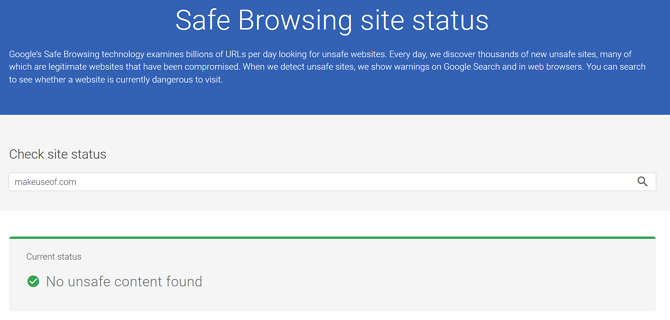
In May 2007, a year before Google launched their Chrome web browser, the search engine debuted its Safe Browsing anti-malware effort. They’d recognized that malware is commonly spread through “drive-by downloads” from compromised web servers. Google couldn’t patch the vulnerabilities in your web browser and plugins, but they decided they could alert you to potentially compromised websites in your search results.
Safe Browsing now protects over three billion devices worldwide. It’s not just Google products either—Safe Browsing is integrated into Firefox and Safari too. Even apps like Snapchat have begun to use Google’s Safe Browsing API to keep their users safe. As we live in an increasingly mobile world, Google has set an Unwanted Software Policy for Android. Any apps found to be in breach of that policy display warnings about misuse of data through Safe Browsing too.
3. HTTPS Everywhere
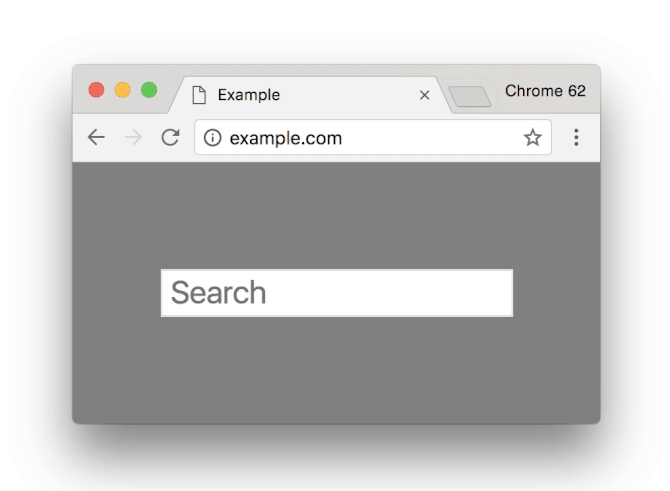
Your connection to a website isn’t secure; at least it didn’t use to be. If the URL of a site begins HTTP, then the connection isn’t encrypted. This means that any data sent between your device and the website’s server could be intercepted. These are known as man-in-the-middle attacks and allow an attacker to insert themselves between both devices and read all the data. Sites that handle sensitive data, like email and online banking providers, have used HTTPS encryption for many years to secure your data in transit.
Google decided that Chrome should do more to warn you when your connection isn’t encrypted. This helps you decide whether to enter payment details and to identify phishing websites. The padlock next to the URL bar is a simple and clear visual aid to keep you informed. Although this was progress, Google decided this still wasn’t enough.
Chrome is the world’s most popular web browser with a 60.6% usage share. Decisions and features implemented in Chrome have a significant impact across the internet. So when Google decided to advocate for the adoption of HTTPS it had a huge knock-on effect. They began moving non-HTTPS websites lower down search rankings, and displaying a “not secure” warning alongside Chrome’s padlock. It was initially placed only on HTTP sites that asked for your data, but in July 2018, Google enabled the “not secure” warning for all non-HTTPS sites.
4. Google Play Protect
To stem the flow of Android malware, Google introduced Google Play Protect at their developer conference I/O 2017. Android had security protections, but they often didn’t communicate with one another, gave vague advice, and required a fair amount of input from you. Play Protect unites a lot of these features under one name. It now protects over two billion devices and scans 50 billion apps every day.
Play Protect uses machine learning to help identify Potentially Harmful Apps (PHA). By training the system to recognize patterns of behavior similar to known PHAs, it can scan new apps and identify any that may be PHAs. According to Google, the behaviors include “apps that attempt to interact with other apps on the device, access or share your personal data, download something without your knowledge, connect to phishing websites, or bypass built-in security features.” Google’s security team reviews potential PHAs for confirmation. That information is fed back into the machine learning algorithms to improve its detection capabilities.
5. Accounts Settings & Security Checkup
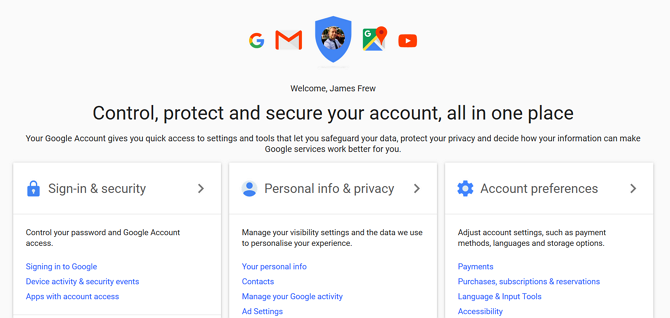
Hopefully, this won’t come as a surprise, but Google knows a lot about you; probably more than you realized. Unlike some of their contemporaries, though, they understand the importance of trust. You’d only feel comfortable with Google handling your location, emails, calendar, search history, YouTube uploads, and more, if you could be sure that data stays safely locked away inside your account.
As it contains so much personal information, the security of your Google account is critical, not just to you, but to Google too. The My Account dashboard has been designed to make securing your account and managing the data Google holds about you easy to maintain. The sidebar navigation lets you quickly switch between Sign-In & Security, Personal Info & Privacy, and Account Preferences.
Their Security check-up tool even guides you through the most crucial security settings so that if you don’t want to deep dive into all the settings, you don’t have to. When using Google products, you’ll occasionally be prompted to review your security settings. In the past, Google has even given away free Google Drive storage as a reward for completing the checkup.
Unlike Facebook, where a labyrinth of complex options get in your way, Google makes it very easy to view and remove data stored in your account. Navigate to the My Activity page, and you’ll be able to find your full history, filterable by product and date. Either select the data you want to delete or use the “Delete activity by” tool to easily find the information you want to be removed.
Do You Trust Google?
In many ways, Google deserves its reputation as a security and privacy nightmare. Their longstanding motto “don’t be evil” was even recently removed from the preface of their code of conduct. This was right around the time they courted controversy with their involvement in developing AI for military drones.
Despite these apparent concerns, Google is a large, complex company with many aims. Their commitment to security—even if it comes at the detriment to your privacy—is commendable. By using their considerable influence to remove malware from Android, and nurture the development of security professionals around the world, Google makes the internet safer for us all.
Read the full article: 5 Surprising Ways Google Improves Your Online Security
Read Full Article
AI spots legal problems with tech T&Cs in GDPR research project
Technology is the proverbial double-edged sword. And an experimental European research project is ensuring this axiom cuts very close to the industry’s bone indeed by applying machine learning technology to critically sift big tech’s privacy policies — to see whether AI can automatically identify violations of data protection law.
The still-in-training privacy policy and contract parsing tool — which is called ‘Claudette‘: Aka (automated) clause detector — is being developed by researchers at the European University Institute in Florence.
They’ve also now got support from European consumer organization BEUC — for a ‘Claudette meets GDPR‘ project — which specifically applies the tool to evaluate compliance with the EU’s General Data Protection Regulation.
Early results from this project have been released today, with BEUC saying the AI was able to automatically flag a range of problems with the language being used in tech T&Cs.
The researchers set Claudette to work analyzing the privacy policies of 14 companies in all — namely: Google, Facebook (and Instagram), Amazon, Apple, Microsoft, WhatsApp, Twitter, Uber, AirBnB, Booking, Skyscanner, Netflix, Steam and Epic Games — saying this group was selected to cover a range of online services and sectors.
And also because they are among the biggest online players and — I quote — “should be setting a good example for the market to follow”. Ehem, should.
The AI analysis of the policies was carried out in June, after the update to the EU’s data protection rules had come into force. The regulation tightens requirements on obtaining consent for processing citizens’ personal data by, for example, increasing transparency requirements — basically requiring that privacy policies be written in clear and intelligible language, explaining exactly how the data will be used, in order that people can make a genuine, informed choice to consent (or not consent).
In theory, all 15 parsed privacy policies should have been compliant with GDPR by June, as it came into force on May 25. However some tech giants are already facing legal challenges to their interpretation of ‘consent’. And it’s fair to say the law has not vanquished the tech industry’s fuzzy language and logic overnight. Where user privacy is concerned, old, ugly habits die hard, clearly.
But that’s where BEUC is hoping AI technology can help.
It says that out of a combined 3,659 sentences (80,398 words) Claudette marked 401 sentences (11.0%) as containing unclear language, and 1,240 (33.9%) containing “potentially problematic” clauses or clauses providing “insufficient” information.
BEUC says identified problems include:
- Not providing all the information which is required under the GDPR’s transparency obligations. “For example companies do not always inform users properly regarding the third parties with whom they share or get data from”
- Processing of personal data not happening according to GDPR requirements. “For instance, a clause stating that the user agrees to the company’s privacy policy by simply using its website”
- Policies are formulated using vague and unclear language (i.e. using language qualifiers that really bring the fuzz — such as “may”, “might”, “some”, “often”, and “possible”) — “which makes it very hard for consumers to understand the actual content of the policy and how their data is used in practice”
The bolstering of the EU’s privacy rules, with GDPR tightening the consent screw and supersizing penalties for violations, was exactly intended to prevent this kind of stuff. So it’s pretty depressing — though hardly surprising — to see the same, ugly T&C tricks continuing to be used to try to sneak consent by keeping users in the dark.
We reached out to two of the largest tech giants whose policies Claudette parsed — Google and Facebook — to ask if they want to comment on the project or its findings.
A Google spokesperson said: “We have updated our Privacy Policy in line with the requirements of the GDPR, providing more detail on our practices and describing the information that we collect and use, and the controls that users have, in clear and plain language. We’ve also added new graphics and video explanations, structured the Policy so that users can explore it more easily, and embedded controls to allow users to access relevant privacy settings directly.”
At the time of writing Facebook had not responded to our request for comment.
Commenting in a statement, Monique Goyens, BEUC’s director general, said: “A little over a month after the GDPR became applicable, many privacy policies may not meet the standard of the law. This is very concerning. It is key that enforcement authorities take a close look at this.”
The group says it will be sharing the research with EU data protection authorities, including the European Data Protection Board. And is not itself ruling out bringing legal actions against law benders.
But it’s also hopeful that automation will — over the longer term — help civil society keep big tech in legal check.
Although, where this project is concerned, it also notes that the training data-set was small — conceding that Claudette’s results were not 100% accurate — and says more privacy policies would need to be manually analyzed before policy analysis can be fully conducted by machines alone.
So file this one under ‘promising research’.
“This innovative research demonstrates that just as Artificial Intelligence and automated decision-making will be the future for companies from all kinds of sectors, AI can also be used to keep companies in check and ensure people’s rights are respected,” adds Goyens. “We are confident AI will be an asset for consumer groups to monitor the market and ensure infringements do not go unnoticed.
“We expect companies to respect consumers’ privacy and the new data protection rights. In the future, Artificial Intelligence will help identify infringements quickly and on a massive scale, making it easier to start legal actions as a result.”
For more on the AI-fueled future of legal tech, check out our recent interview with Mireille Hildebrandt.
Read Full Article
Google Admits Third-Party Apps Can Read Your Gmail

Google has moved to assure Gmail users that their inboxes are private and secure. However, in doing so it has admitted that third-party apps can read your Gmail, and that this is all your fault. After all, you’re the one giving developers access.
For many years, Google analyzed the emails passing through your Gmail inbox for advertising purposes. However, in 2017, Google announced it was going to stop scanning your emails altogether. Unfortunately, that doesn’t apply to third-party apps.
Can Developers Read My Gmail?
The Wall Street Journal recently published an article claiming software developers “scan hundreds of millions of emails of users who sign up for email-based services.” This includes an accusation that some developers allow employees to read emails.
Google was quick to fire back, making it clear that no one at the company reads your emails. However, in a post on The Keyword, Google admits that third-party apps can indeed access the content of your Gmail account once you give them permission.
Here's how to check your #Gmail messages can't be read by staff at external companies pic.twitter.com/IKsIMQy1EH
— Adam Richards (@Adam_Rds) July 4, 2018
The fact is that whenever you allow a third-party app to access your Gmail account, you’re opening yourself up to the possibility that someone, somewhere is reading your emails. It may never happen, but once access has been granted you can never be 100 percent sure.
Google insists that all apps face “a multi-step review process that includes automated and manual review of the developer, assessment of the app’s privacy policy and homepage to ensure it is a legitimate app, and in-app testing to ensure the app works as it says it does.”
You Control Your Own Data
The point is that you are in control of your data at all times. When you add an app to Gmail you’re shown what permissions that app is requesting, and you can refuse. Unfortunately, that usually means not being able to use that app at all.
If you’re concerned that you have granted dodgy developers access to your Gmail you can view and control permissions you have previously granted on myaccount.google.com. And if you find any you either no longer use or trust you can revoke those permissions.
Image Credit: Chris Schrier/Flickr
Read the full article: Google Admits Third-Party Apps Can Read Your Gmail
Read Full Article